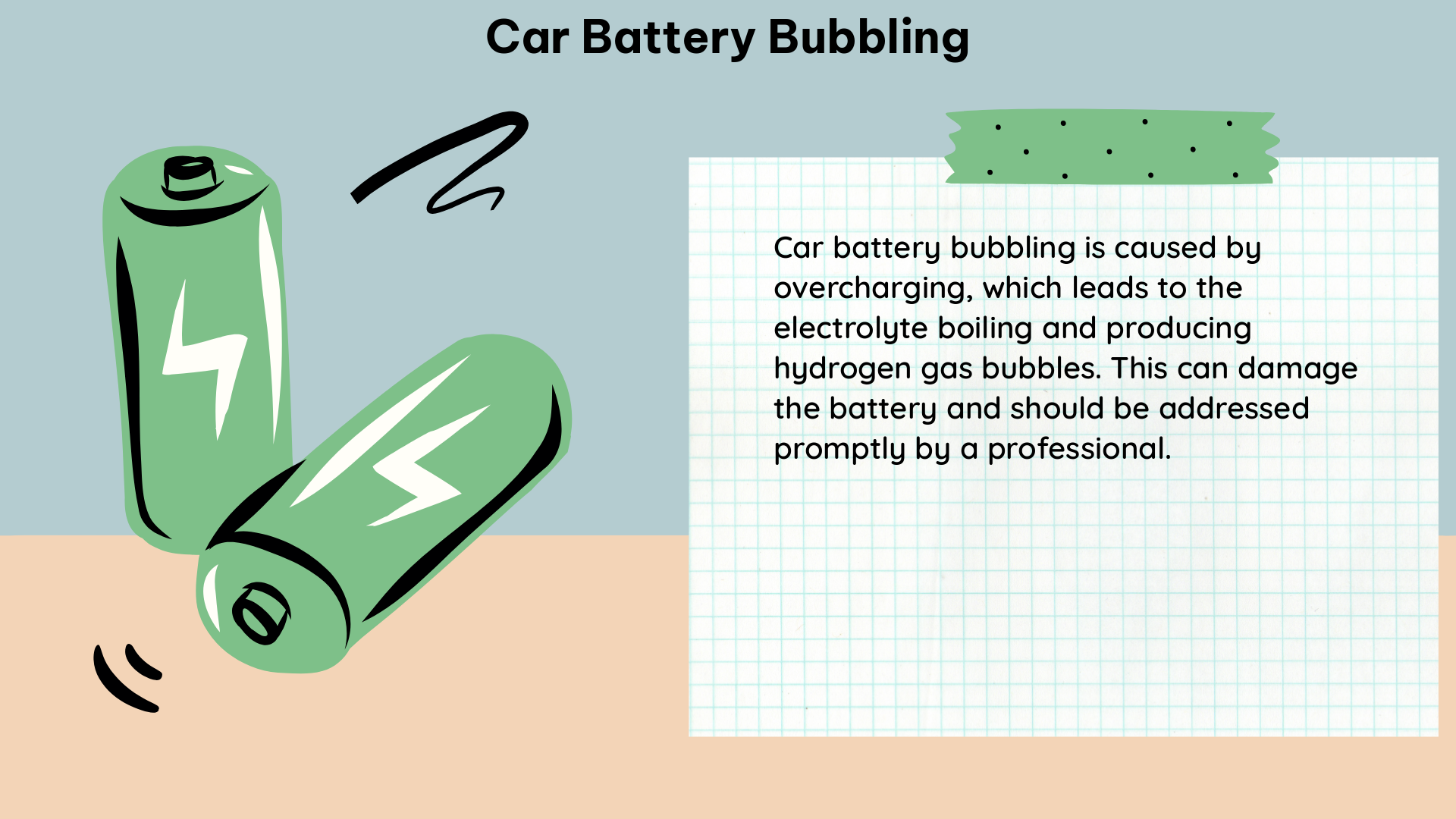Car battery bubbling is a common occurrence that can be attributed to the complex chemical reactions taking place within the battery, particularly during the charging process. This phenomenon is a result of the electrolysis of water, leading to the formation of hydrogen and oxygen gases that are released through the battery vents. Understanding the underlying causes and implementing proper maintenance practices are crucial to ensuring the longevity and safe operation of your car’s battery.
The Science Behind Car Battery Bubbling
The primary cause of bubbling in a lead-acid car battery is the process of electrolysis, which involves the separation of water (H2O) into its constituent elements, hydrogen (H2) and oxygen (O2). This process occurs due to the transfer of electrons between the battery’s positive and negative plates, a fundamental aspect of the charging and discharging cycle.
During the charging process, the discharged negative lead plates (lead sulfate) undergo a transformation where the sulfate (SO4) is separated, forming sulfuric acid (H2SO4) and water (H2O). Simultaneously, the positive lead plates are converted from lead dioxide (PbO2) back to lead (Pb). These chemical reactions result in the formation of hydrogen and oxygen gases, which are then released through the battery vents, creating the characteristic bubbling sound.
The rate of gas formation and the intensity of the bubbling can be influenced by several factors, including:
- Charging Rate: Overcharging the battery can lead to excessive gassing and increased bubbling, as the chemical reactions are accelerated.
- Electrolyte Concentration: The concentration of sulfuric acid (H2SO4) in the electrolyte solution can affect the rate of gas formation. Maintaining the proper electrolyte level and specific gravity is crucial.
- Battery Age and Condition: Older batteries or those with issues such as sulfation are more prone to excessive gassing and bubbling, as the chemical reactions become less efficient.
- Battery Type: Different battery technologies, such as absorbed glass mat (AGM) batteries, may exhibit less bubbling during charging compared to traditional lead-acid batteries.
Differentiating Bubbling, Boiling, and Gassing

It is essential to understand the differences between bubbling, boiling, and gassing in car batteries, as they have varying degrees of severity and potential safety implications.
-
Bubbling: As mentioned earlier, bubbling is a natural occurrence during the charging process and is generally not a cause for concern. The bubbling sound is a result of the release of hydrogen and oxygen gases through the battery vents.
-
Boiling: Boiling is a more severe condition that can occur when the battery is overcharged or the electrolyte level is too low. In this case, the electrolyte solution can reach a boiling point, leading to the rapid release of gases and potential damage to the battery.
-
Gassing: Gassing refers to the excessive production and release of hydrogen gas, which is highly combustible. Gassing can occur due to overcharging, sulfation, or other battery-related issues and poses a significant safety risk, as it can lead to battery explosions.
Preventing Car Battery Bubbling
To minimize the potential issues associated with car battery bubbling and ensure the safe and efficient operation of your vehicle’s battery, it is crucial to follow these guidelines:
- Proper Charging Practices:
- Use a compatible charger that is designed for your specific battery type and capacity.
- Avoid overcharging the battery by monitoring the charging process and adhering to the recommended charging times and voltages.
-
Consider using a smart charger or a charger with a built-in automatic shut-off feature to prevent overcharging.
-
Battery Maintenance:
- Regularly check the battery’s water level and top it up with distilled water as needed to maintain the proper electrolyte balance.
- Clean the battery terminals and connections to ensure good electrical contact and prevent corrosion.
-
Monitor the battery’s specific gravity using a hydrometer to ensure the electrolyte concentration is within the recommended range.
-
Battery Replacement:
- Replace batteries that are no longer holding a charge efficiently or exhibiting signs of excessive gassing or sulfation.
-
Consider upgrading to a different battery technology, such as an AGM battery, which is less prone to acid stratification and sulfation.
-
Environmental Factors:
- Avoid exposing the battery to extreme temperatures, as both high and low temperatures can accelerate the chemical reactions and lead to increased gassing.
- Ensure the battery is securely mounted in the vehicle to prevent vibrations, which can contribute to premature battery failure and excessive gassing.
By following these best practices, you can effectively manage and prevent car battery bubbling, ensuring the longevity and safe operation of your vehicle’s power source.
Conclusion
Car battery bubbling is a natural phenomenon that occurs due to the complex chemical reactions within the battery, particularly during the charging process. Understanding the underlying causes, differentiating between bubbling, boiling, and gassing, and implementing proper maintenance practices are crucial to maintaining the health and safety of your car’s battery.
By adhering to the guidelines outlined in this comprehensive guide, you can minimize the risks associated with car battery bubbling, extend the battery’s lifespan, and ensure the reliable performance of your vehicle’s electrical system.
References:
– Reddit Discussion on Car Battery Bubbling
– Battery University: Sulfation and How to Prevent It
– Battery University: Acid Stratification and Surface Charge
– Battery University: Charging Lead-Acid
– Automotive Battery Maintenance and Safety

The lambdageeks.com Core SME Team is a group of experienced subject matter experts from diverse scientific and technical fields including Physics, Chemistry, Technology,Electronics & Electrical Engineering, Automotive, Mechanical Engineering. Our team collaborates to create high-quality, well-researched articles on a wide range of science and technology topics for the lambdageeks.com website.
All Our Senior SME are having more than 7 Years of experience in the respective fields . They are either Working Industry Professionals or assocaited With different Universities. Refer Our Authors Page to get to know About our Core SMEs.